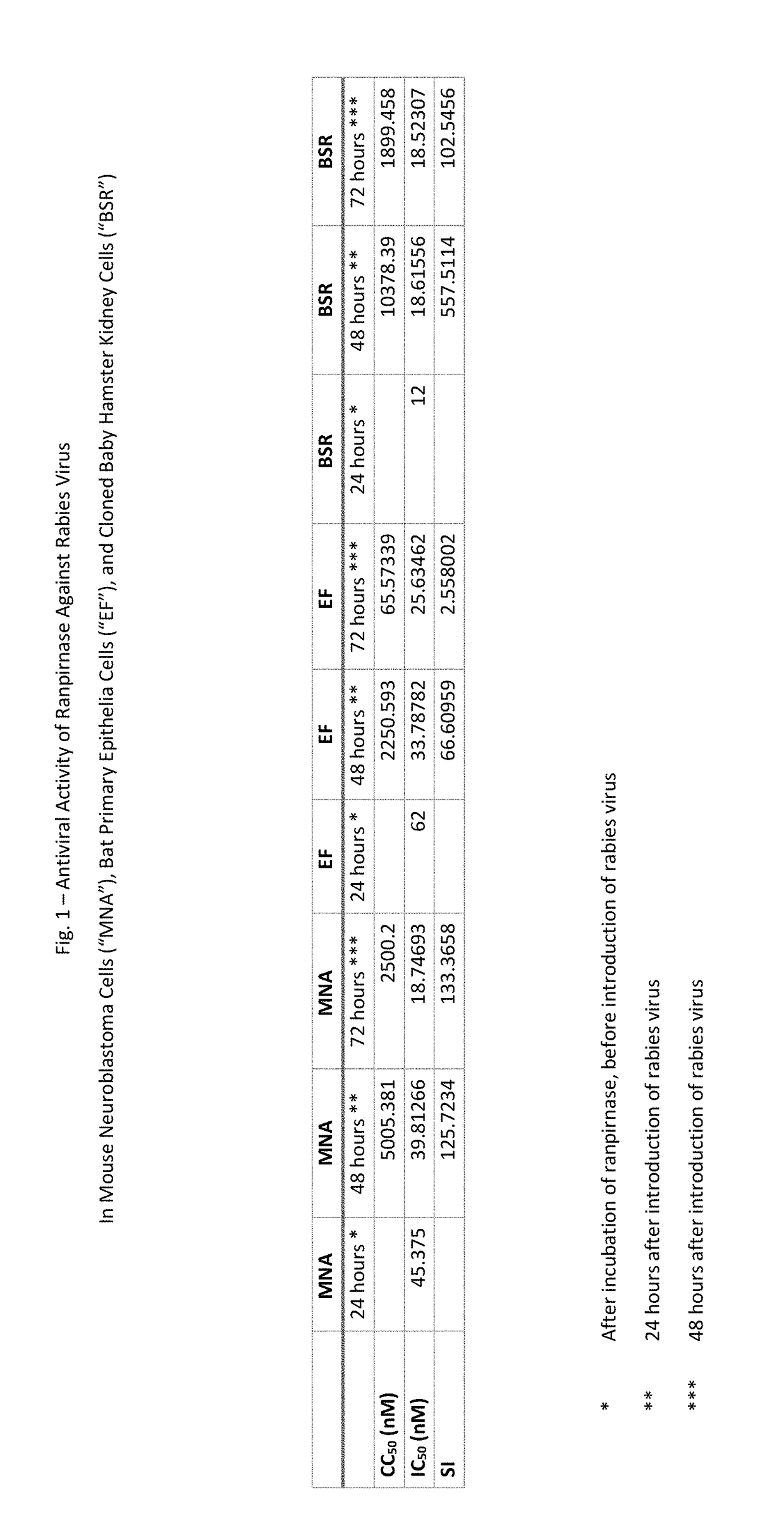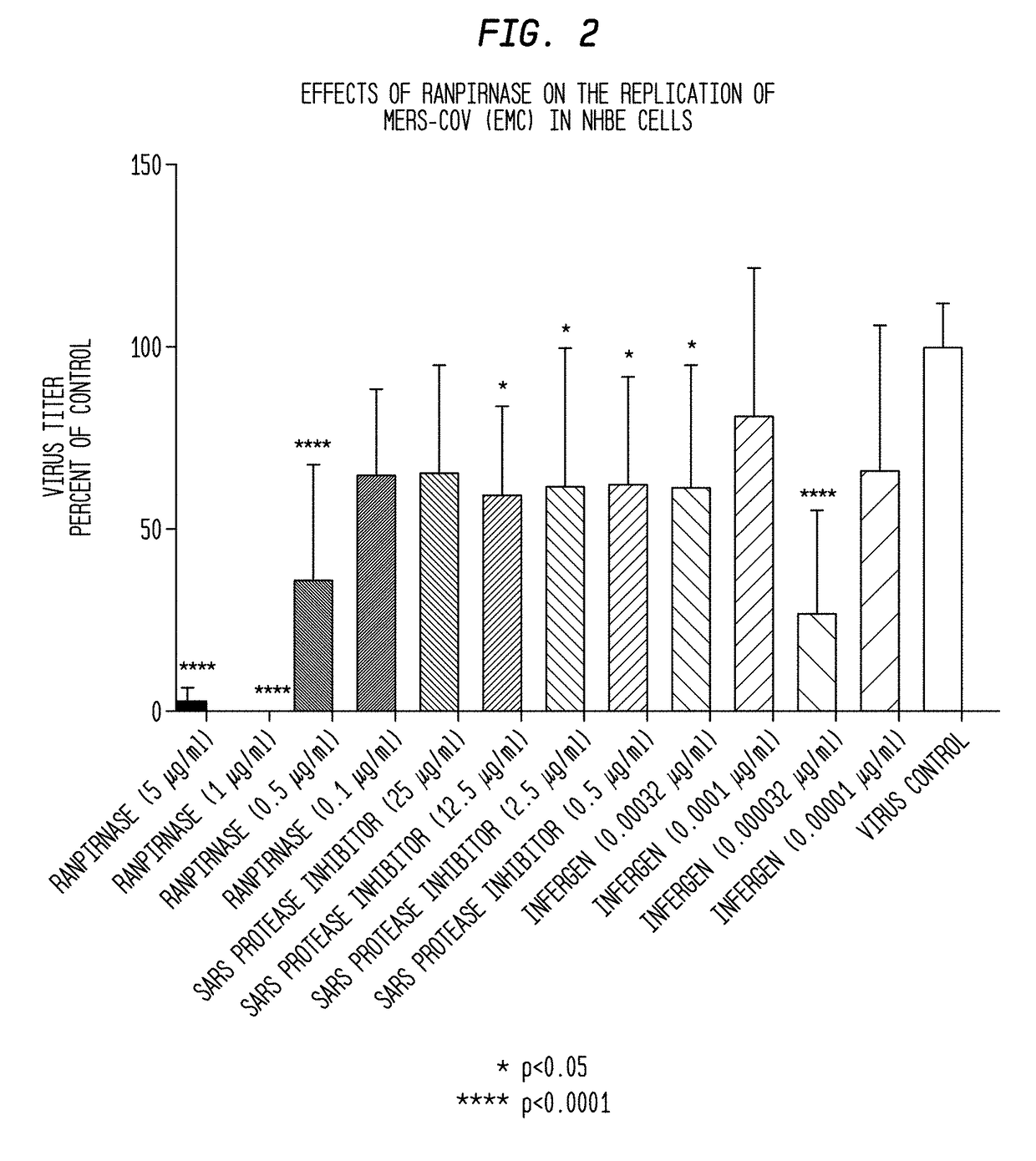Methods of treating and prophylactically protecting mammalian patients infected by viruses classified in Baltimore group V
a virus and baltimore technology, applied in the field of viral infection treatment in mammalian patients, can solve the problem of virus eventually dying
- Summary
- Abstract
- Description
- Claims
- Application Information
AI Technical Summary
Benefits of technology
Problems solved by technology
Method used
Image
Examples
example 1
MEM, EF, and BSR Cells
[0050]In the experiments described in FIG. 1, the density of each of the cell lines under test was adjusted to 50,000 cells / ml using minimal essential media (MEM). The cells were placed in wells and incubated at 37° C. and 0.5% CO2 for 24 hours. Ranpirnase was diluted to concentrations of 10 uM, 3 uM, 900 nM, 270 nM, 81 nM, and 24 nM, added to the wells, and incubated at 37° C. and 0.5% CO2 for 24 hours.
[0051]Rabies virus at a multiplicity of infection (“MOI”) of 0.1 was then added to each of the wells and the ranpirnase and rabies virus—containing wells were incubated at 37° C. and 0.5% CO2 for 72 hours.
[0052]The virus in each of the wells was titrated 24 and 48 hours after introduction of the rabies virus using mouse neuroblastoma cells, and the results are shown in FIG. 1.
[0053]The selectivity index SI is an accepted measurement of the ability of a drug under test to inhibit replication of a viral infection without killing the infected cells. Where SI in the...
example 2
in NHBE Cells
[0055]In the experiment illustrated in FIG. 2, the anti-viral activity of ranpirnase against MERS-CoV virus was compared to the activities of two known anti-viral agents: SARS protease inhibitor and Infergen. The experiment was carried out using four different concentrations of each agent on normal human bronchial epithelial (NHBE) cells.
[0056]More specifically, the NHBE cells were grown in HEPES Buffered Saline Solution at 37° C. for seven days. The cells were washed and refreshed once daily. Two controls were used: one contained MERS-CoV virus and the other contained uninfected NHBE cells that were treated with the agents under test.
[0057]On the eighth day, the tested concentrations of the three agents under test were introduced into the cells and buffer solution and the virus was introduced at a multiplicity of infection (“MOI”) of 0.01. The virus- and agent-containing samples were then incubated for 72 hours at 37° C. and 5% CO2, with the medium being replenished on...
example 3
in NHBE Cells
[0061]In the experiment illustrated in FIG. 3, the anti-viral activity of various concentrations (5 μg / ml “Ranp-5”, 1 μg / ml “Ranp-1”, 0.5 μg / ml “Ranp-0.5”, and 0.1 μg / ml “Ranp-0.5”) of ranpirnase against influenza A / California / 07 / 2009(H1N1)pdm09 virus was compared to the activities of various concentrations of two known anti-viral agents (Ribavirin at 320 μg / ml “Riba-320”, 100 μg / ml “Riba-100”, and 10 μg / ml “Riba-20” and Oseltamivir carboxylate at 25 μM “Osel-25”, 10 μM “Osel-10”, and 1 μM) “Osel-1”. The experiment was carried out on NHBE cells using four different concentrations of ranpirnase and three different concentrations of each of the other agents. Three controls were used. The first control was NHBE cells that were infected by the virus and treated with a placebo. (This control is shown in FIG. 3.) The second control was NHBE cells that were “infected” with a placebo and treated using the agents under test. The third control was NHBE cells that were “infected” ...
PUM
| Property | Measurement | Unit |
|---|---|---|
| concentrations | aaaaa | aaaaa |
| concentrations | aaaaa | aaaaa |
| concentrations | aaaaa | aaaaa |
Abstract
Description
Claims
Application Information
 Login to View More
Login to View More - R&D
- Intellectual Property
- Life Sciences
- Materials
- Tech Scout
- Unparalleled Data Quality
- Higher Quality Content
- 60% Fewer Hallucinations
Browse by: Latest US Patents, China's latest patents, Technical Efficacy Thesaurus, Application Domain, Technology Topic, Popular Technical Reports.
© 2025 PatSnap. All rights reserved.Legal|Privacy policy|Modern Slavery Act Transparency Statement|Sitemap|About US| Contact US: help@patsnap.com



